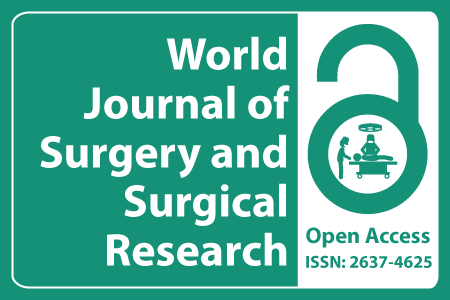
Journal Basic Info
- Impact Factor: 1.989**
- H-Index: 6
- ISSN: 2637-4625
- DOI: 10.25107/2637-4625
Major Scope
- Cardiovascular Surgery
- Ophthalmology & Eye Surgery
- Oral & Maxillofacial Surgery
- Robotic Surgery
- Gastroenterological Surgery
- Hand Surgery
- Cancer Surgery
- Neurological Surgery
Abstract
Citation: World J Surg Surg Res. 2021;4(1):1317.DOI: 10.25107/2637-4625.1317
Comparison of Conventional vs. Oncoplastic Breast-Conserving Surgery in a Breast Unit with Oncoplastic Training
Fernando Hernanz*, Jaime Jimeno, Lucía Paz, Javier Anchuelo, Erik González and Pedro Muñoz
Department of Breast, Marqués de Valdecilla University Hospital, University of Cantabria, Spain
*Correspondance to: Fernando Hernanz
PDF Full Text Research Article | Open Access
Abstract:
Purpose: Oncoplastic Breast Conserving Surgery (OBCS) has been tested in oncological terms
demonstrating that it is as effective as Standard Lumpectomy (SL) nowadays; Patients-Reported
Outcomes (PRO) have become a relevant way to assess breast cancer treatment. The aim of this
work was to compare OBCS with SL using a PRO measurement, BREAST-Q Breast Conserving
Therapy (BCT) module.
Methods: One hundred and sixty-five patients with early primary breast cancer treated with BCT
were questioned using BREAST-Q Version 2.0 BCT Module, postoperative scales, in Spanish, after
radiotherapy treatment was administered. The patients filled in the questionnaire in a paper-andpencil
format at our breast unit. The sample size was estimated to observe differences of 7 points in
the satisfaction with breast domain (postoperative scale) between both approaches. This difference
is slightly higher than 10% of the median of satisfaction with breast domain reported in published
studies. An analysis was done to compare statistics.
Results: SL was used in 108 patients and OBCS in 57. Patients treated with OCBS had a larger
radiological lesion than patients treated with SL (median 20 mm vs. 15 mm) corresponding with a
higher pathological tumor (17 mm vs. 13 mm). The time from the radiotherapy end date to when
the questionnaire was filled in was longer in those patients treated with OBCS (mean 8 vs. 15.5
months). No significant statistical differences were found in the BREAST-Q postoperative domain
scores between both approaches.
Conclusion: The quality of life and the satisfaction with the oncoplastic breast conserving approach
or the standard lumpectomy evaluated by the BREAST-Q were similar in our breast unit.
Keywords:
Oncoplastic breast-conserving surgery; Breast-conserving therapy; Patient-reported outcomes; BREAST-Q
Cite the Article:
Hernanz F, Jimeno J, Paz L, Anchuelo J, González E, Muñoz P. Comparison of Conventional vs. Oncoplastic Breast- Conserving Surgery in a Breast Unit with Oncoplastic Training. World J Surg Surgical Res. 2021; 4: 1317..













